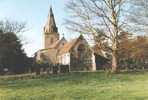 Burton Joyce Burton Joyce
St Helen
Stonework
Description of the stones
The tower wall fabric is built of pale pinkish-brown, cross-bedded, fine sandstone
ashlar blocks. Note the many small pits or holes weathered in to the sandstone
block faces. The old spire apex now placed at ground level is also pale reddish
brown, fine cross-bedded sandstone comparable to that in the tower fabric.
The new basal plinth is a pale cream to buff-coloured oolitic and shelly limestone.
The south aisle (a ?later Victorian reconstruction) is faced with large blocks
of cream to reddish brown oolitic and shelly limestone. Note on the south side
of the chancel there is a return to greenish grey cross-bedded, fine sandstones
as in the Tower. These stones have distinctive pinprick weathering holes on
their surface and also show the raised tubular bumps seen at Lambley
Church.
The north aisle walls are principally fine sandstones as in the tower but
at the eastern end the lower courses are a pale grey sandy limestone or skerry.
Most of the original ashlar sandstone blocks are Triassic Waterstones (Sneinton
Formation).
The pale grey skerry sandstones are from the Triassic Mercia Mudstone Group
and occur in thin beds above the Waterstones sandstone unit.
The oolitic and shelly limestones are from the Middle Jurassic Lincolnshire
Limestone and are similar to stones quarried at Ancaster and Clipsham quarries.
Comparable buildings
Waterstones are used at Gedling, Woodborough and
Epperstone.
Skerry sandstone are more widely used in churches further to the north east eg East
Bridgford (Nave) Normanton on Trent, Winkburn and Maplebeck etc.
| 




